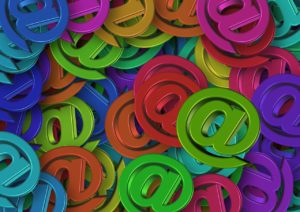Join the “You’ve Got Mail” Revolution
Why email communication at all?
For better or for worse, our business and social lives rely heavily on email. Sometimes our seemingly archenemy, email does have a strong communicative core and the potential to be used effectively.
Don’t we all love our flooded email inboxes after a two-week vacation; the sea of unopened digital messages awaiting our response? Why hasn’t Outlook created an automatic pre-response, telling people not to email in the first place if we’re Out Of Office (OOO)? While I cannot imagine that anyone truly loves his or her email, I still believe in its communicative functionality. Like most anything, if used properly and organized effectively, email can be a powerful tool. Here’s how to use email communication to your benefit in 3 phases:
Phase One: Personal
Assess the number of email accounts you currently have and what each one’s purpose is. I suggest having one email for coupons/shopping (a spam email) and one for personal correspondence with family, friends, banks, travel, etc. I find that having a SPAM email to use when I want to subscribe to certain websites and newsletters substantially diminishes the mess in my personal inbox. It is also an email that I can purposefully go into when you have extra time to catch up on the world or weed through coupons. So, do you still have an old AOL or Hotmail account that you should upgrade to a new email platform like Gmail or Yahoo? Do you have too many accounts that you have forgotten about? Go through your account list and clean it up, and create a new SPAM email in addition to your personal.
Phase Two: Professional
Take the time to get to know your work email platform. Whether it’s a computer in an office or a professional account, whether it’s Outlook or Gmail, spend an hour going through the settings, creating a tag system, organizing folders, and setting up tasks. You’ll know you have a fully functioning email system when you can concisely and simply answer the question, what do you do when an email hits your inbox? For example, when I get an email, I decide whether I can take immediate action or not. If not, I flag its due date, set a reminder on a specific day, and place it into the appropriate folder. Designate a set amount of time to work out a quick, understandable system.
Phase Three: Universal
Join the “You’ve Got Mail” Revolution and adopt the new email lingo. First, in the subject line of an email add your ask, such as “Action Required: Tomorrow’s Sales Meeting” or “Confirmation: Tues 3pm” or “Report: Twitter Analytics”. By adding this, a person in a hurry can make a much quicker decision as to what to do with your email. Secondly, speak in bullets. Imagine you’re in an elevator and have exactly 2 floors to tell the person inside your message. Lastly, sign off by re-stating the purpose of the email, be it “the ask” or the conclusion, and more importantly, whether or not you need a response. If you do not need a response, let the person off the hook from engaging in a ‘thank you’/’sounds good’ correspondence and write: “no response necessary”. The hope is that people will catch on, but even if they don’t, you’ll be helping yourself and those around you in the email-verse. LinkedIn agrees. Join the You’ve Got Mail Revolution.
How do you use your email efficiently? What tricks or tactics do you use on a daily basis in order to have effective communication?


